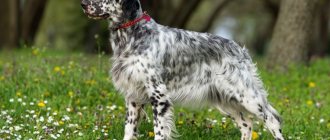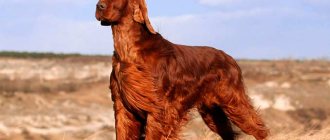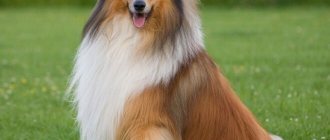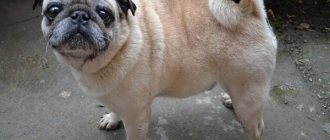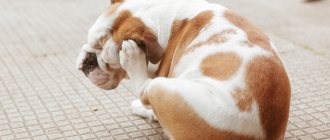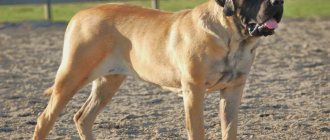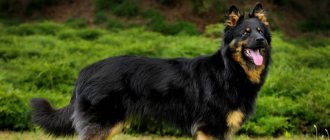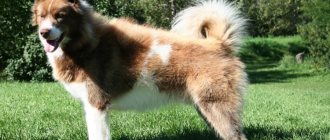Breed characteristics
| Short description | |
| Origin: | UK, Scotland |
| Conditions of detention: | House with or without garden |
| Purpose: | Hunting dog (gun dog), companion dog |
| Color: | Black and Tan |
| Wool length: | Long |
| Adult dog size: | The height of the female is 62 cm, the male is 65 cm; male weight – 29.5 kg, female – 25.5 kg |
| Average life expectancy: | 10-13 years |
| Walk: | Walking twice a day is required |
| Physical activity needs: | High physical activity needs (1.5-2 hours of active walking or training per day) |
| Fédération Cynologique Internationale (FIC) classification: | Group 7: Pointers, Section 2: British and Irish Pointers and Setters |
| Puppy price: | From 10 to 35 thousand rubles. Without pedigree - 10-12 thousand rubles, pet class - up to 20 thousand rubles, breed class - up to 28 thousand rubles, show class - 35 thousand rubles |
Health and illness
The description of the Scottish Setter breed speaks of good health, but due to the large weight of the animal, there may be a tendency to dysplasia of the pelvic joints. There are also eye diseases such as cataracts and progressive retinal atrophy. Pets sometimes suffer from bloating. They fight this with fractional nutrition. Periodic examinations by a veterinarian will help prevent the development of these pathologies.
Lifespan
Dogs of the Gordon Setter breed live up to 12 years, the average life expectancy is 10 years . With inadequate nutrition and lack of care, pets live 5-7 years. According to scientists, sterilized individuals live longer.
History of the origin of the species
Hunting with gun dogs became popular in England during the 16th and 17th centuries. Before this, hunters preferred Spaniels, which blew up game from the ground or snow. The Setting Spaniel was considered a special species, which found a bird and took a stance, without the person having to hit the prey in the air.
Popularity in the Settings grew, and then cops began to appear. The largest spaniels were selected for further improvement. There is a version that Bloodhounds, Pointers and other English gundogs took part in the mixing. All dogs differed in color and size; the breed acquired its general appearance only by the 19th century.
The greatest contribution to the development of Setters was made by Alexander Gordon, Duke of Scotland in the late 18th and early 19th centuries. He liked the working qualities and appearance of the folding rock. Two kennels were opened in his castle: for Deerhounds and Setters. He formed a single color - black and tan and determined the first standard. The dogs received their second name, “Gordon,” in honor of the Duke.
In 1842, one Scottish Setter was sent to America, where the Kennel Club recognized the breed in 1884. The dogs avoided the division into working and show dogs. Modern Gordons can hunt and show off at exhibitions at the same time, although they prefer a free life.
The breed is not considered popular. In terms of working qualities, she is inferior to other cops in speed and agility, but remains a loyal friend and companion. Usually, Scottish Setters are purchased by hunters who are not chasing victory, for the sake of it.
History of the breed
The homeland of the Scottish Setter is Great Britain.
The history of this breed began in the eighteenth century. Initially, setters were kept by Scottish hunters with low and middle incomes; the rich were not interested in them for the time being. Ordinary hunters also bred these dogs; they valued their pets for their endurance, hunting qualities and loyalty.
The Duke of Gordon played a huge role in making the setter popular with the nobility. It was he who was involved in improving and breeding the breed for many years.
The ancestors of the modern Scottish Setter are the ancient black and tan spaniels, black pointing dogs that were very popular in those days in England and Scotland.
The Gordon Setter is the result of many years of work by breeders. During the formation of the breed, crossbreeding was carried out with Irish setters, pointers, bloodhounds and spaniels.
Selection work lasted until the end of the nineteenth century. At the end of the twentieth century, the popularity of the Scottish Setter was observed in almost all countries of the world. In 1988, the breed standard was officially adopted.
Gordon's performance couldn't help but rejoice. Such a dog is capable of hunting all day in any place, in any weather, and it would not be noticeable that he was tired. His task is to track down the game and, using the special stance of the setter, indicate its location to the owner.
Recently, the Scottish Setter has become less and less used as a hunting dog. More and more often, representatives of the breed become participants in exhibitions. Gordon breeding is mostly carried out in the exhibition direction, while hunting abilities and instincts are significantly reduced.
Today it is not included in the list of “fashionable” types of dogs.
Distinctive features
This is the largest among the Setters, similar in appearance to the English and Irish, but much more powerful and taller . Dogs can reach 65 cm at the withers, and their weight is 25-29 kg . The breed is muscular, with strong limbs and bone structure. A distinctive feature is the long wavy coat, which is characterized by a single color - black and tan.
- The head is voluminous, dry, with a pronounced stop , flat between the ears.
- The muzzle is equal in length to the skull, square, with a straight back of the nose. The lips are soft, fleshy, the upper one is much larger than the lower one, and droops slightly. bite (the upper teeth overlap the lower teeth);
- The nose is wide, black, with open nostrils;
- The eyes are medium-sized, widely set, dark brown in color; the look is a little sad due to the drooping upper eyelid;
- The ears are long, thin, wide. Set at eye level, hanging down and close to the head;
- The body is stretched, muscular and heavy. The topline slopes slightly from the withers to the horizontal croup. The withers are pronounced. The stomach is tucked. The neck is long and wide. The chest is wide and well let down.
- The tail is a continuation of the lower back, set low, hangs down when calm, not long and thick. When active, it does not rise above the croup.
- Limbs are straight, dry, parallel and widely spaced. The paws are round with clenched toes. The movements are sweeping and free.
- The coat is long, wavy, thick, shiny, soft. Forms feathering on the ears, tail, underline, and back surface of the limbs.
- The color is black and tan, white markings on the chest are allowed, but are considered undesirable.
Description of the breed
The English Setter is an extremely friendly and good-natured dog, considered one of the oldest gundogs. The body of the English Setter is covered with wavy, long, slightly silky hair with a curly undercoat. The most common colors are: lemon white, liver white, black and white, tricolor. Let us also add that these dogs have drooping, folded ears, pressed tightly to the head.
The current breed standard was approved by the FCI in 2009. English Setters are elegant dogs of medium height. These are friendly, active, good-natured dogs, born hunters. The English Setter's movements are graceful, free, and reflect the dog's endurance. Males grow up to 65-68 cm, females - up to 61-65 cm.
- The English Setter's head is long, moderately dry, the transition from the forehead to the nose is well defined, and the skull is rounded.
- The ears are set low and hang down in folds along the cheeks. The length of the ears is medium, the upper part of the ear is covered with silky hair, and the tips of the ears are velvety.
- The eyes are oval, not protruding. Color ranges from dark brown to hazel. The darker the eye color, the better, but for liver-belton (brown-mottled) dogs, a lighter shade is acceptable. The look is clear, expressive and soft.
- The English Setter has a straight nose. The nose is brown or black, in accordance with the color of the dog. The nostrils are well open and wide.
- The bite in dogs is scissor-shaped, even and correct. The muzzle is almost square, the lips should not be too drooping.
- The dog's body is of moderate length, the loin is somewhat convex, wide and muscular.
- The chest is deep in front and wide between the shoulder blades. The ribs are convex and well sprung.
- The back of the English Setter breed is short and straight.
- The forelimbs are muscular, straight, with the elbows tightly fitting to the body. The feet are arched, with well-developed pads and well-arched toes, gathered into a ball.
- The hind limbs of the English Setter are covered with well-developed muscles, and the thighs are long. The toes are well arched and tightly packed, with protective fur growing between the toes. The pads are developed.
- The tail is of medium length. Set almost at the level of the back. Saber-shaped or somewhat curved, but not curled upward. The decorative hair grows from the base of the tail; towards the middle of the tail the length of the hair increases, towards the tip it shortens. The decorative hair is shiny, silky, long, wavy (not curly!). When moving, the dog carries its tail at the level of its back or slightly lower, and happily waves it.
- The English Setter's coat behind the ears is somewhat wavy, but not curly. Like all the hair on a dog's body, it is long and silky. There is decorative hair on the hind and forelimbs.
We advise you to read: Basset Hound Dog Breed
The color of the English Setter can be black and speckled (blue belton), lemon speckled (lemon belton), orange speckled (orange belton), and brown speckled (liver belton). Uniform speckling is preferred rather than large spots. Belton is an English village name traditionally used to name the colors of English Setters. The term “Belton” was introduced by E. Laverack, which significantly influenced the classic appearance of the breed.
Photo of an adult dog
Price of puppies
Puppies of all varieties of Setters should be purchased from private breeders or nurseries. Be sure to ask the sellers for documents and pedigree. You should not take a puppy from unverified owners from advertisement sites or social networks; there is a risk of buying the wrong breed. Pay attention to the price.
The standard cost is 10,000 rubles . If a pet is purchased for further participation in exhibitions, the price increases to 40,000-50,000 rubles.
Advice! You can buy an animal from your own hands, but prices from responsible breeders differ slightly from the prices in nurseries.
Setter dogs are loyal, friendly animals, a little demanding in care and training, but completely worth the owner’s investment. Buying a puppy should be done by adults, not teenagers, who have free time to fully raise their pet. Preferably kept in a private house with a large territory.
Photos of puppies
Education and training
Owners who understand the psychology of their pet and have managed to position themselves as a leader claim that working with Gordons is a pleasure. People who fail to do this have difficulty training their dog. If you feel that you cannot cope with a wayward pet, it is better to seek help from an experienced specialist and not waste your time and nerves.
In any case, raising a Scottish Setter is a long-term job that will require not only a lot of time and mental strength, but also love. You need to start training from puppyhood; it is recommended to conduct classes in different places so that the dog remembers commands faster.
Don't make the lesson long and monotonous. As soon as the pet is tired, you need to stop the activity. It is recommended to learn commands during walks, after your four-legged friend has done his “business” and has had time to get a little hungry.
The Scottish Setter is very difficult to retrain. If he executes a command incorrectly, it will be incredibly difficult to get it executed correctly. For the same reason, you should not ignore minor violations on the part of the dog. If you once allow her to climb into her owner's bed or chew a bone in the middle of the carpet in the living room, she will do this all the time.
Physical punishment, like yelling, is simply unacceptable. Commands must be given in a clear, confident and calm voice. And be sure to encourage their correct implementation with treats.
The Scottish Setter matures very late. Until the third year of life, it is a puppy, very large, but still a puppy. You need to take this circumstance into account and properly structure your communication with the dog, and make appropriate demands on it.
Features of character and behavior
You can often come across negative comments about a dog's temperament. In fact, Gordons are calm, balanced, non-aggressive and playful. The main disadvantage is stubbornness. If the owner does not take up raising the pet in time, the animal will never learn the rules of behavior and manners.
Another distinctive feature is eternal childishness. Setters remain puppies until they are 3-4 years old, and it is difficult even for a large person to cope with a 27 kg puppy. Therefore, keeping the breed in an apartment is not the best idea.
In general, Gordons are good hunters, friendly dogs and loyal friends. Although such a pet is not suitable for everyone.
Advantages
The main breed advantages include:
- Good working abilities, endurance to long hunting and temperature changes;
- High intelligence, developed hunting instinct;
- Devotion and loyalty to one person;
- Friendliness, good relationships with children, household members, even small pets;
- Tolerance of other dogs and strangers;
- Politeness, intelligence;
- Playfulness, activity, positivity.
Flaws
Most often, the negative aspects of the breed are revealed by owners who have not encountered such dogs before and do not know how to find a common language with them. Setters need to be trained from birth, because an older dog will not be retrained. In addition, cops are quite stubborn; the owner must be persistent and serious.
There are several breed deficiencies characteristic of each individual:
- Stubbornness, willfulness, inflexibility in decisions;
- Distrustful attitude towards strangers;
- Dominance in a pack of dogs, especially among males (can get involved in fights);
- Tendency to escape (undermining, jumping over fences);
- Intolerance of loneliness and separation from the owner;
- The need for high physical activity;
- Jealousy towards the owner;
- Difficult relationships with very young children who “torment” the dog;
- A long process of growing up (until 3-4 years old, Setters remain puppies).
Pros and cons of the breed
If you are a busy person who will not be able to devote much time to your dog, then the Scottish Setter breed is absolutely not suitable for you. Such a dog requires constant attention; he needs daily physical and mental stress. Below is a list of the main pros and cons of Gordon:
Advantages:
1. Beautiful, jet-black wool and luxurious wool dewlaps. 2. High intelligence. 3. Friendliness, loyalty. 4. Efficiency, endurance. 5. The hunting instinct is well developed. 6. Easy to care for and not expensive to maintain. 7. Good health.
Care and maintenance
It is impossible to keep a cop in cramped conditions; the best option is a country house with an adjacent territory. Free walking is suitable for the dog.
Chains and enclosures are a categorical taboo, because Setters love space and freedom.
The area needs to be well fenced, soft earth should be laid with tiles so that Gordon does not dig under the ground.
The issue of difficulty in keeping is that the Scottish coat is long and soft. They need frequent brushing, trimming, and haircuts. Cops also need a lot of physical activity, training and education.
Before buying a puppy, you need to triple the space for it in the house and in the yard: install a comfortable booth, purchase a lounger and place it in a place without drafts and sunlight. It is vital for a pet to be near its owner and family. It is also worth purchasing items for use: bowls on stands, toys, hygiene products.
The eyes and ears are examined daily; there is a risk of developing otitis media. Therefore, if you have any discharge from the ears, you should contact your veterinarian. Teeth are brushed 2 times a week with special pastes or chewing ropes. If the claws do not grind down on the asphalt on their own, they should be trimmed at least once a month .
Nutrition
Adult Scottish Setters are active and strong, but with uncontrolled nutrition they are prone to obesity. In order to replenish their energy reserves, their diet should consist of food rich in protein.
If dry food is your priority, then you should choose a special type of product with a high protein concentration, intended for active breeds of dogs. The ideal option would be premium holistic therapists.
Before purchasing, be sure to study the composition of the product, since Gordons are very sensitive to allergenic substances, low-quality food can cause indigestion.
Most often, food that the dog consumed in the kennel is used for feeding. If you plan to change food to natural food or other products, the transition should be carried out gradually. To begin with, you can feed your pet with products that are included in the new food so that it adapts faster.
Unlike dry food, natural food is considered healthy and familiar to the animal. The daily menu should consist of meat (veal, lamb, chicken, rabbit) and cereals (rice, buckwheat, oatmeal). You can feed them fruits and vegetables several times a week. It is allowed to feed deboned sea fish, eggs and low-fat fermented milk products. Foods that should absolutely not be given to a dog include:
- Pork;
- Butter;
- Bones;
- Flour and confectionery products;
- Legumes and potatoes;
- Fatty and fried.
Puppies should be fed 4-5 times a day, adults should be fed about 2 times a day. Depending on activity, a portion of dry food is approximately 600 grams per day. If the dog’s diet consists of natural products, then a vitamin complex should be added to it. To choose the right drug, you should contact your veterinarian.
We recommend that you read a detailed article on the topic: “How and what to feed a dog: types and characteristics of nutrition.”
Health
The breed is distinguished by good health and immunity. Dogs live from 10 to 13 years, but with proper care, individuals are able to cross the “border” at 15 years. They are prone to some breed diseases that occur due to improper care.
Hunting dogs are in dire need of vaccination because they deal with wild animals. Dangerous viral diseases are poorly treated and therefore pose a danger to animals, especially young ones.
Vaccinations
The most important vaccinations for a pet are carried out in the first year of life, at which time the vaccination schedule is the busiest. The first two procedures are carried out in the nursery, where a veterinary passport is issued. The owner is notified about this and a further schedule of vaccinations is given.
- Complex vaccination is carried out at 2, 2.5, 6 and 12 months , repeated annually because it loses its effect. A drug against leptospirosis, parainfluenza, plague, enteritis and other viral diseases.
- Rabies vaccination is carried out at 7 months and requires annual repetition.
Vaccination does not provide complete protection against infection, but it does provide the pet with immunity, which will make it easier for him to fight the virus. Unvaccinated dogs are not able to overcome the disease and cope with treatment, and most often die. Puppies and pregnant bitches are especially susceptible to infections.
In addition, without two vaccinations done in the last 12 months, the pet cannot be taken abroad. According to the laws of the Russian Federation, the pet must be vaccinated and examined by a veterinarian no later than 20 days before transportation.
There are several rules that must be applied when vaccinating:
- Firstly, the pet is dewormed 14 days before vaccination.
- Secondly, walking is prohibited until the second vaccination, as well as after each procedure for 2 weeks.
- Thirdly, on the day of vaccination, the dog’s temperature is measured; unhealthy or malnourished pets are not allowed to participate in the procedure.
Vaccinations are carried out in veterinary clinics so that if an allergic reaction occurs, it is possible to provide first aid.
If you observe side effects (weakness, nausea, frustration, refusal to eat) for more than a day, you should contact the clinic.
Important article on the topic: “Everything you need to know about dog vaccinations.”
Diseases
Problems specific to Scottish Setters:
- Hip dysplasia (a pathological hereditary disease caused by weakness of cartilage tissue, which causes the pet’s paws to become deformed due to physical activity; there is no cure);
- Cataract;
- Retinal atrophy;
- Glaucoma (increased blood pressure in the eye);
- Gastric volvulus and digestive problems.
Walk
Gordons are very active pets, they are constantly on the move. Not only do they need free access to the local area, it is important to provide the dogs with active walking twice a day. They should be given regular training for all muscle groups; hunting or field trials would be a good option. If the owner is involved in sports: running, cycling, rollerblading, then the Setter will happily support his hobbies.
Small dogs are gradually accustomed to the street: in the first 2-3 days after the second vaccination, they are carried out in their arms, then put on a leash, and later they take walks in the parks.
At the end of socialization, the puppy is introduced to public transport or noisy places. Scots need to take a Dog in the City course to adapt to urban conditions.
It is not advisable to let your pet off the leash, only if it is completely obedient. Otherwise, Gordon will simply run away when he smells game or other dogs.
Grooming
Long hair requires careful grooming, otherwise only scissors will be able to remove tangles. Pets are brushed daily with a long-toothed brush, and after walks, debris is removed from the strands. 2-3 times a year, dogs are trimmed by groomers and cut for the summer. Dogs shed lightly, but their hair is long, so it is noticeable on furniture and carpets.
Setters are bathed once every 2 months with gentle shampoos. If the dog is heavily soiled, you can wipe the dog with a towel or rinse it without hygiene products. After swimming in ponds, your pet needs to be washed. In rainy and muddy weather, it is recommended to wear a raincoat or protective overalls.
During the warmer months, it is important to treat your dog with flea and tick repellents. Deworming (cleansing of worms) is carried out every 2 months.
Origin
It can be argued that the spaniel is the ancestor of the Scottish setter.
To obtain this variety it was necessary to cross in different directions. Because of this, a large number of dog species were bred, depending on the terrain where dogs were needed for hunting.
Selection was carried out with large similar breeds in order to consolidate and increase hunting qualities.
The first who paid attention to this breed of dogs were Thomas Cloke and Henry Paget. They started with black and tan setters.
Further, one of the aristocrats liked the bred look and he continued the selection of the breed in order to improve the qualities of the hunter, but retain a bit of the exterior.
To achieve this, breeds were crossed with shepherd dogs, Irish setters, hounds, pointers and bloodhounds, due to which the color was tan.
The work on breeding the breed was continued by the son of aristocrat Alexander Gordon, Georg. It was he who managed to develop this breed of dog in 1860, which was named after the breeder - the Gordon Setter.
Mating
Dogs are knitted when they are fully formed. Although puberty begins early (at 10-12 months), it is recommended to breed only at 2-3 years. The female will be physically and mentally ready to bear and give birth to puppies. During the third or quadruple heat (the most favorable period), symptoms of readiness will appear: a loose loop, light discharge, a playful mood.
Mating through the nursery is carried out for breeding individuals. The owners set a mating date, fill out forms and receive a certificate. The cost of mating depends on the wishes of the owner of the dog. Usually it is equal to 1 puppy.
On the appointed day, the girl is brought to the territory of the male dog. It is best to walk your pets together so they can socialize. Then the boy will mount if the female allows him. For the first time, it is better to invite a specialist who will help the owners understand the process.
After several active movements, the animals will freeze and stand in a castle. This state will last 15-20 minutes . It is important not to let the bitch sit down, but to hold the dog by the croup. If there was no lock, then the girl may be pregnant. Mating is repeated after 2 days . The course of pregnancy is monitored at a veterinary clinic.
Read a detailed article on the topic: “Everything you need to know about breeding dogs: appropriate age, what to do if it doesn’t work out, rules and tips.”
Health
Dogs of this breed have a strong genetic base, so with good care they rarely get sick. However, they have a tendency to the following diseases:
- Otitis.
- Intestinal volvulus.
- Hip dysplasia. It affects many animals as they age.
- Spondylosis.
- Epilepsy. Moreover, this disease occurs in Irish setters more often than in other breeds intended for hunting.
- Retinal atrophy. This pathology is quite common and causes complete blindness.
Experienced breeders reduce the likelihood of these diseases to a minimum by promptly examining their pets with veterinarians and taking preventive measures.
Irish Setter. Dog Breeds
Key points in training
Education must begin from the first days of life, otherwise you may miss the moment. The Scottish Setter will not study all his life; it is easier for him to do everything the way he remembered at the very beginning. In addition, he will not obey a weak person, so it is important to maintain the hierarchy in the family and not allow the dog to be wayward.
If Gordon is interested in learning, he easily makes contact and remembers commands, but he will need a lot of treats and encouragement.
Rough methods are not welcome; the pet is touchy and can become overly aggressive.
Read about how to properly train a dog in the article: “Training a puppy: effective methods from dog handlers, learning commands at home.”
Ignoring and a stern look are suitable for punishment.
To train hunting instincts, dogs are given to dog handlers who specialize in such dogs. They will help to reveal all the talents and teach the pet to be in order. If the animal is bought “for the soul”, then courses at the club will also not hurt. Every dog should know basic commands.
Character, abilities, skills
Scottish Setter Gordon: description of the dog breed
The setter is a smart, intellectually developed, sociable, and friendly dog. Her hunting qualities are well developed, but her guard qualities are not at all developed. These dogs will not be the best guards, but they will become excellent bloodhounds: they quickly pick up a scent and follow it well. They are very loyal to their owner and the whole family, but can conflict with other dogs.
These are very mobile, active animals. They love to run and enjoy bathing and swimming in the summer. Small puppies are especially active and it’s hard to keep up with them. Having matured, they remain just as athletic, but after proper training they can control their behavior.
Affectionate dogs get along well with children and can become excellent nannies. They understand words perfectly, are obedient, and are easy to train.
Irish Red Setter
How to choose a puppy
Gordons are not a popular breed, so acquiring one can be a challenge. The nursery will provide the necessary documents, the breeder will provide information about the parents, content, and breed diseases. In addition, he will help you decide on a puppy and recommend a brand of food and hygiene products.
The cost of a pet directly depends on its class and age.
- Pet class – puppies with slight deviations from the standard – is the cheapest option.
- Breeding class – dogs suitable for breeding.
- The most expensive - show class - show pets.
If a dog is purchased at the age of 6-12 months, it will also cost more. The pet will be trained in commands and will undergo some kind of field testing, which means that it is easy to determine its working qualities.
Setter puppies are always active and curious. The price varies from 10 to 35 thousand rubles.
Scottish Setters are not domestic animals. These are serious, strong dogs designed for hunting and working. They have not yet lost their working qualities and are valued as weapons. Therefore, before getting such a pet, you need to think about the possibilities and conditions for keeping it.
Buying puppies
Any owner of this breed, when asked where to buy a Scottish Setter, will answer you that you can only buy it in a very good nursery or from a breeder who is a professional in this and has a huge reputation.
The price of a small Scottish Setter puppy starts from approximately 36,000 thousand rubles.
Main characteristics
| Breed parameters | |
| Country of origin: | Great Britain |
| Weight of the breed: | males: 25-36 kg, females: 20-32 kg |
| Height at withers: | males: 61-69 cm, females: 58-66 cm |
| Temperament: | active |
| Wool: | average |
| Role in human life: | companion, hunting |
Despite the large number of advantages, the breed has not become fashionable. This happened due to the Scottish Setter’s great mobility and unsuitability for small spaces. The dog will not be able to get along in an apartment unless it has a significant square footage. It is much more familiar and easier for a hunter to scour the area of a private house. Temperament will not allow the setter to become a simple pet.
Dog character
High social and physical activity, love for people are the defining features of the black and tan setter. The pet has a positive attitude towards training, but patience and a demanding attitude are required. The animal acquires a habit, begins to understand its owner, perceives it as a leader, and then becomes attached to him.
Children are the main source of joy for a setter; Gordon will never offend a child, he is always happy to communicate and play together. And yet the four-legged friend requires mutual respect. If you drag your pet by the ears, pull its fur, or scream non-stop, then the acquaintance will end quickly and unsuccessfully. The unpleasant aftertaste will remain for a long time.
The Scottish Gordon takes a long time to grow up; for 2-3 years the pet will be restless and playful. During this period of formation, the dog should be educated and taught the right habits. Retraining does not go smoothly for the pet. Usually the dog ignores the new rules for a long time, having become accustomed to the old order. If he eats and sleeps in a certain place, then changes will only cause misunderstanding.
